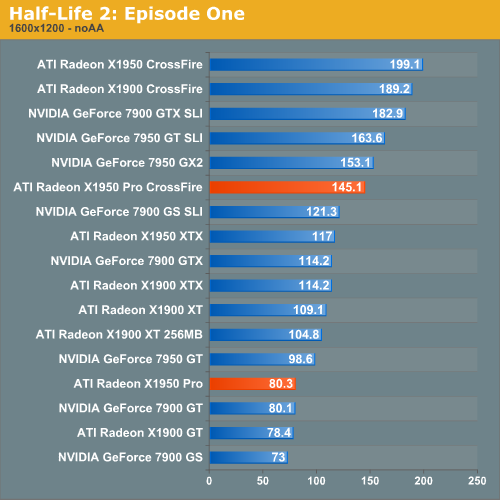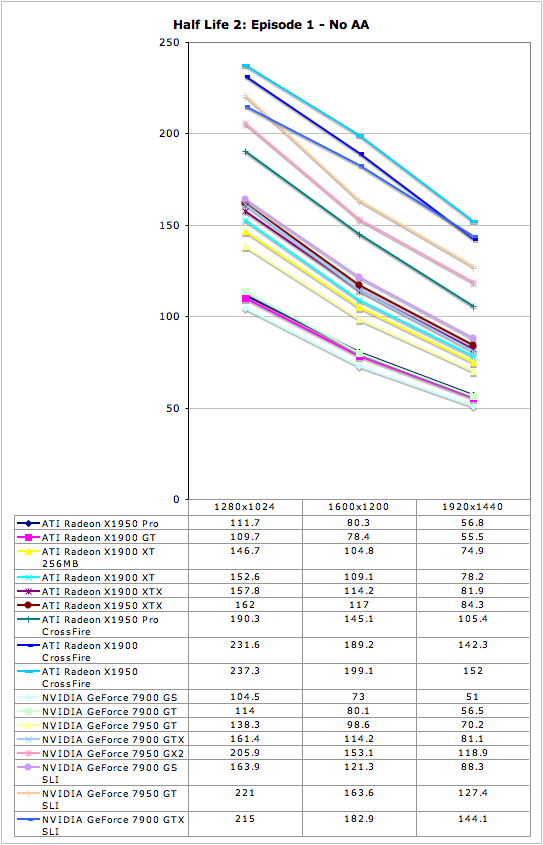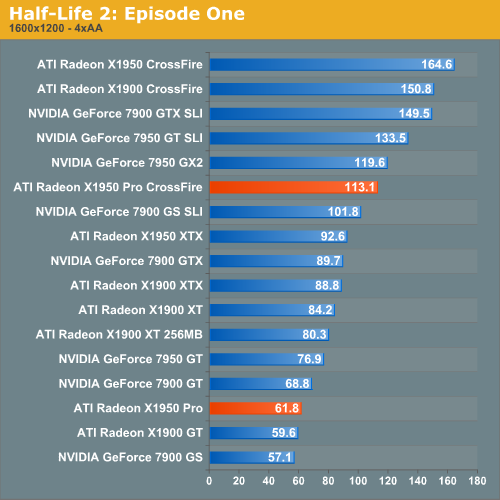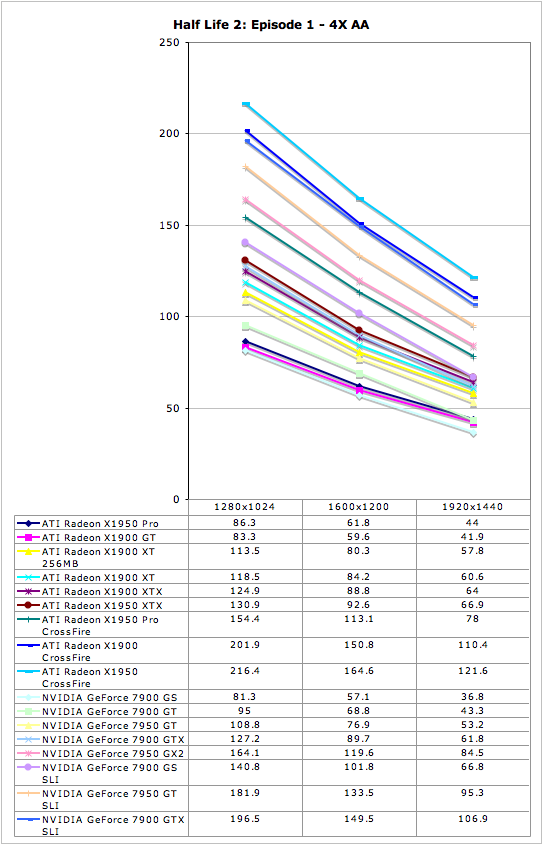ATI Radeon X1950 Pro: CrossFire Done Right
by Derek Wilson on October 17, 2006 6:22 AM EST- Posted in
- GPUs
Half-Life 2: Episode One Performance
Episode One of the new Half-Life 2 series makes use of recent Source engine
updates to include Valve's HDR technology. While some people have done HDR
that won't allow antialiasing (even on ATI cards), Valve put a high value on
building an HDR implementation that everyone can use with whatever settings
they want. Consistency of experience is usually not important enough to
developers who care about pushing the bleeding edge of technology, so we are
very happy to see Valve going down this path.
We use the built-in timedemo feature to benchmark the game. Our timedemo
consists of a protracted rocket launcher fight and features much debris and
pyrotechnics. The Source engine timedemo feature is more like the nettimedemo
of Id's Doom 3 engine, in that it plays back more than just the graphics. In
fact, Valve includes some fairly intensive diagnostic tools that will reveal
almost everything about every object in a scene. We haven't found a good use
for this in the context of reviewing computer hardware, but our options are
always open.
The highest visual quality settings possible were used including the "reflect
all" setting which is normally not enabled by default, and anisotropic
filtering was set at 8x. While the Source engine is notorious for giving great
framerates for almost any hardware setup, we find the game isn't as enjoyable
if it isn't running at at least 30fps. This is very attainable even at the
highest resolution we tested on most cards, and thus our target framerate is a
little higher in this game than others.

Showing about a 10% performance advantage over the 7900 GS, the X1950 Pro delivers a good level of performance under Half-Life 2: Episode One without AA enabled. Combine that with the fact that CrossFire delivers about an 80% performance improvement to SLI's 66%, and we have a clear winner in the mulit-GPU department here.


Enabling 4xAA under HL2:EP1 closes the gap between ATI and NVIDIA at the $200
mark, but still leaves ATI in the lead. The same is true in the multi-GPU
arena.











45 Comments
View All Comments
DerekWilson - Tuesday, October 17, 2006 - link
First of all, every site uses their own benchmarking techniques and sequences in the games. Numbers between review sites won't be comparable.For Quake 4 we used ultraquality mode, and this seems to give ATI the advantage over NVIDIA. We don't have a problem with this because we would prefer to tip the scales in favor of the product that can deliver the best performance at the highest image quality.
munky - Tuesday, October 17, 2006 - link
Would you rather Ati continued to ship the x1900gt with the original specs, and then a bunch of the cards would have to be RMA'd?DerekWilson - Tuesday, October 17, 2006 - link
We would rather they just run out of x1900 GT cards. They're discontinuing the line anyways, so it seems a little strange to try to increase supply by underhanded means.sri2000 - Tuesday, October 17, 2006 - link
They should ship it under a different model number. Call is the X1900 GTA or something like that (or some other alphabet soup combo that's not already taken) so that people can tell that the different model# = different performance.Goty - Tuesday, October 17, 2006 - link
You guys are ragging on this CF implementation like it's some sub-par solution. The transfer speed may be lower than that used by NVIDIA's SLI bridge, but SLI is simplex while this implementation is full duplex. Being able to send data in both directions at the same time should provide a huge speed boost while using ATi's SuperAA modes.JarredWalton - Tuesday, October 17, 2006 - link
Scalability is the key factory. In most benchmarks, SLI gets more of an improvement than CrossFire, indicating that the compositing engine is not an optimal multi-GPU solution. There's almost certainly a decent amount of overhead involved. We do like the new CF connector, but the proof is in the pudding. If 7900 GS is clearly slower in single card configs but often faster in dual-GPU configs, clearly SLI is scaling better than CF.mesyn191 - Friday, October 20, 2006 - link
I don't think its possible to comment on the new CF at all, they've clearly got screwed up drivers for it ATM, but then its ATi so what else is new...I hope AMD cleans up thier driver team because still even after all these years ATi does a half assed job on its drivers.
Goty - Tuesday, October 17, 2006 - link
Are you guys thinking of doing any testing with any of either vendor's multi-card AA modes any time soon? I really think the full duplex connection would really help there (i.e. the cards may not scale as well with the number of cards, but what about as the image quality increases?)Rza79 - Tuesday, October 17, 2006 - link
The Tech Report had problems with this motherboard and Crossfire which made them switch to the Asus P5W DH.You aren't expiriencing any problems with this board?
Second thing, why no AA with games like B&W2 and FEAR?
DerekWilson - Tuesday, October 17, 2006 - link
No problems with the motherboard.AA performance under Black and White 2 and FEAR were excluded because we decided framerate was already at a minimum for the resolution we were testing.